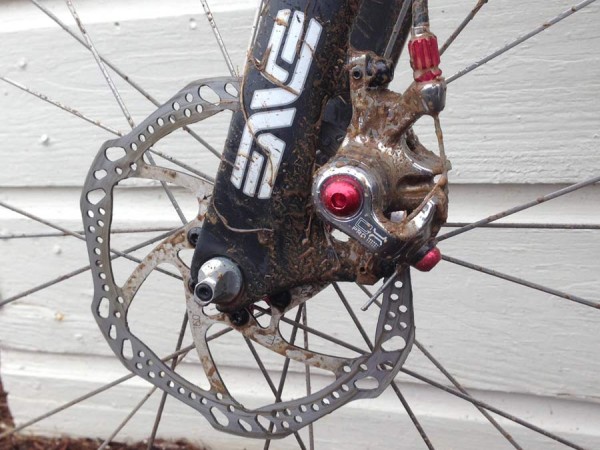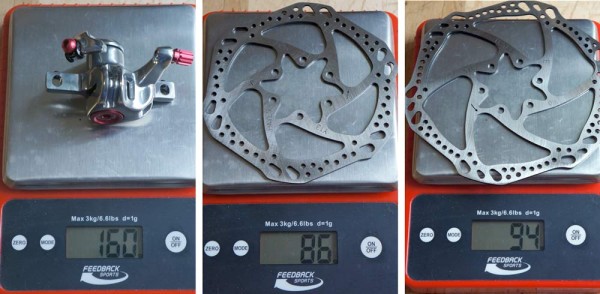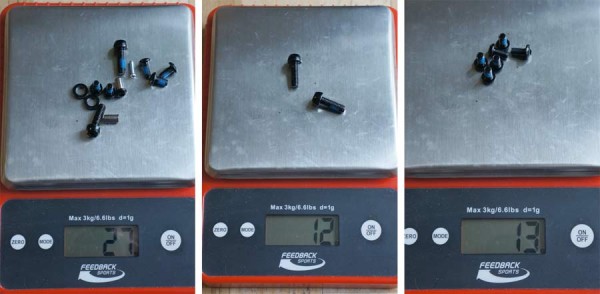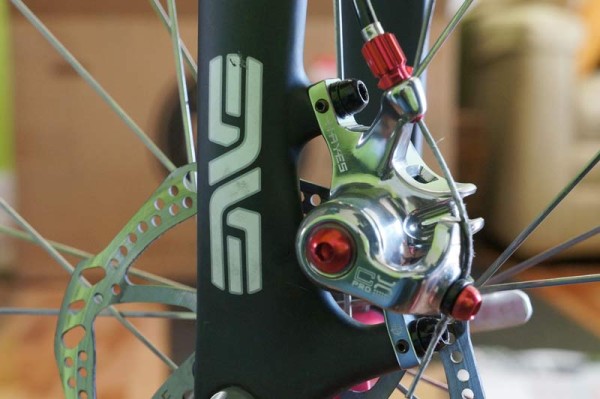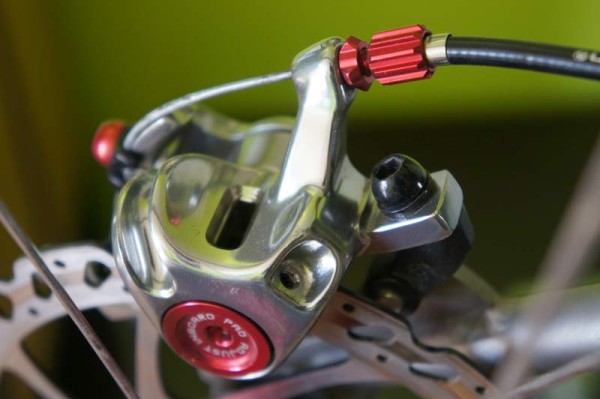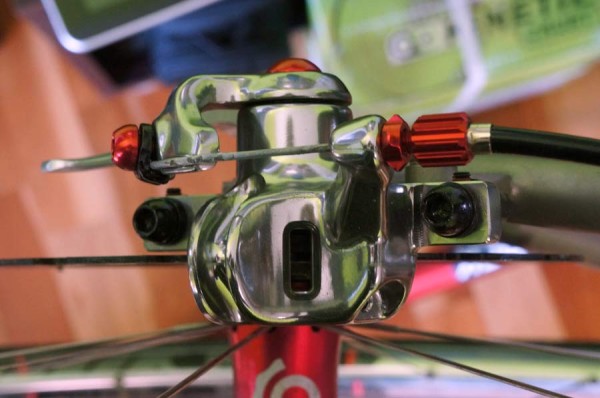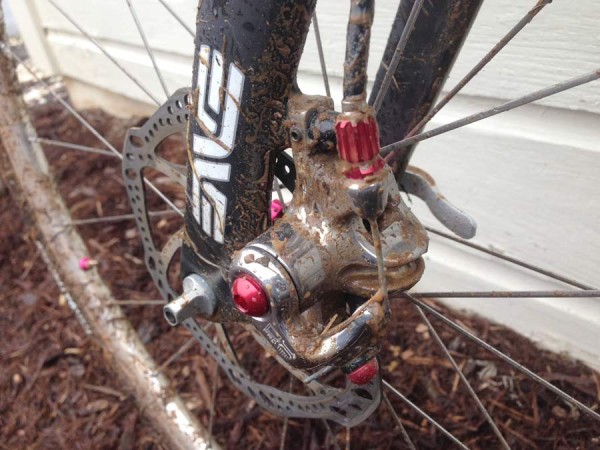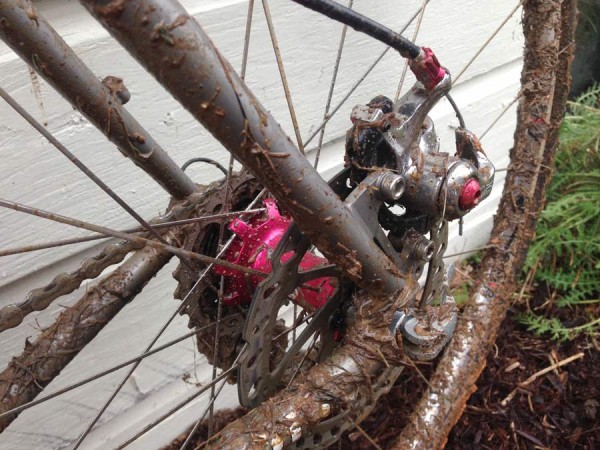Last season, I ran the original Hayes CX5 mechanical disc brakes and reviewed them pretty positively. The only real complaint was the weight, something they addressed with several hotrodded iterations introduced last summer. The real race car of the group is the top level CX Pro, which gets extensive machining and lightweight bits to shave a whopping 37g per caliper.
The rotors are also new. And lighter. And set up is now even easier thanks to the inclusion of their brilliant Crosshair alignment system. But the performance is the same, which is to say very good for a mechanical brake…
ACTUAL WEIGHTS:
Actual weights are 160g per caliper. The new L-Series rotors come in at 86g for the 140mm and 94g for the 160mm. Compared to the V-Series on the CX5 set, that’s a weight savings of 17g and 21g respectively, putting total per-wheel weight savings between 54g and 59g.
It comes with steel hardware as standard (tested), with titanium bits as an option. The full bag of goodies is 27g. Break it down and the caliper mounting bolts are 12g and the rotor bolts are 13g.
All that puts it within a few grams of the Avid BB7 SL and TRP Spyre brakes.
DETAILS & FIRST IMPRESSIONS
The CX Pro and CX Expert (previously the CX5) share a one-piece alloy body with a slightly darkened, polished finish. The key differences between the two is that the CX Pro gets extensive machining on the bridge, a machined vent hole on the body, Crosshair alignment and alloy barrel adjuster with anodized details. It also gets an alloy cable anchor bolt and fixing bolt for the lever arm.
The small black bolts adjacent the caliper mounting bolts are the Crosshair alignment system. In short, it’s brilliant. Simply dial them open, snug the caliper onto the fork or frame while pushing it all the way toward the rotor, then slowly twist the Crosshair screws in until the outer pad is just off the rotor. Then, tighten the mounting bolts completely and adjust the inside pad position (see below) and you’re done. Perfect alignment in less than two minutes, just like they advertise it. Seriously, best adjustment system ever.
The backside has a tooled pad positioning dial that lets you adjust the inboard (non-actuating) pad toward or away from the rotor. The small hole above it is a set screw to keep locked in place. It’s a free turning, non-stepped adjustment, so you can really set it exactly where you want it.
The vent window is new and gives heat somewhere to go. Aesthetically, the brakes are rather handsome. The only complaint is that the lever arm and ball/ramp section juts out a bit further than competitors’ models, but it hasn’t been a performance issue.
These were installed mid-season, following the TRP HYRD set I reviewed recently. So, they’ve seen two races and several training/fun rides so far. In fact, the coating of mud you see here is from their very first ride, which happened to also be the NCCX Greensboro race. It started with a 50 minute “warm up” ride from my house to the venue in 30º drizzly rain. Initial set up was done the night before and prior to watching Hayes’ Crosshair set up video (of which you skip the first 90 seconds). They worked pretty good.
However, after the race, and after watching the set up video* and re-doing it, they worked exceptionally well. It was a small change in set up, but huge gains were made. They’re plenty powerful but easily modulated. The ramp seems linear and provided plenty of range with Shimano Ultegra levers.
All in all, they’re very good, but there were a couple of issues to note: First, the pads are held in place magnetically, and the magnets aren’t super strong. During wheel install, it’s possible to dislodge a pad slightly, making rotor entry impossible. You can simply flick the pad back into place, but quick in-race wheel swaps could be hampered.
Second, when cleaning my bike after that first muddy ride, I noticed one of the calipers had a good bit of grass and mud inside, above the pads and clogging the vent hole. A little bit of the mud had also snuck behind the pads, but not enough to hurt performance.
Lastly, they squeal when wet. Most other brands and models do, too, but I felt I should mention it. Prolonged braking dried them off enough to slowly mute it, but as soon as they got wet again, the noise was back. When dry, they’re perfectly quiet.
Are they right for you? If you prize ease of set up as much as performance, then they’re absolutely worth a look. They’re finally weight competitive, and at $99 per wheel, they’re priced the same or less than the competition. That means the less drilled-out CX Expert is a bargain if you don’t mind a few extra grams. They’ll be on my ‘cross bike for a while longer and I’ll report back if there are any long term concerns.
HayesDiscBrakes.com (*the Crosshair set up video is linked from their homepage)
